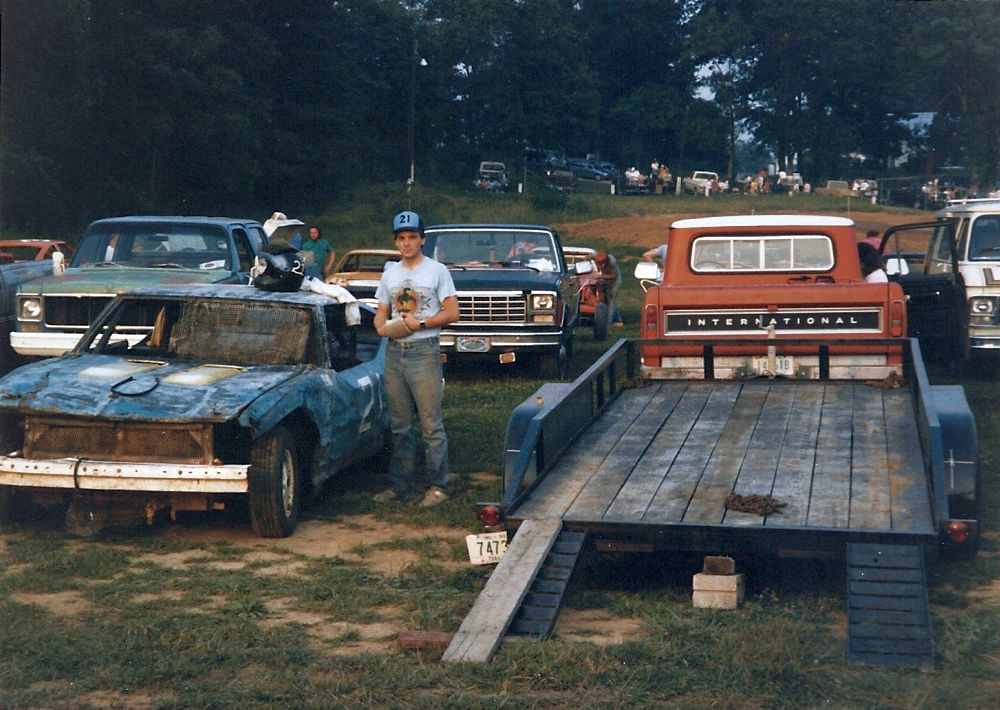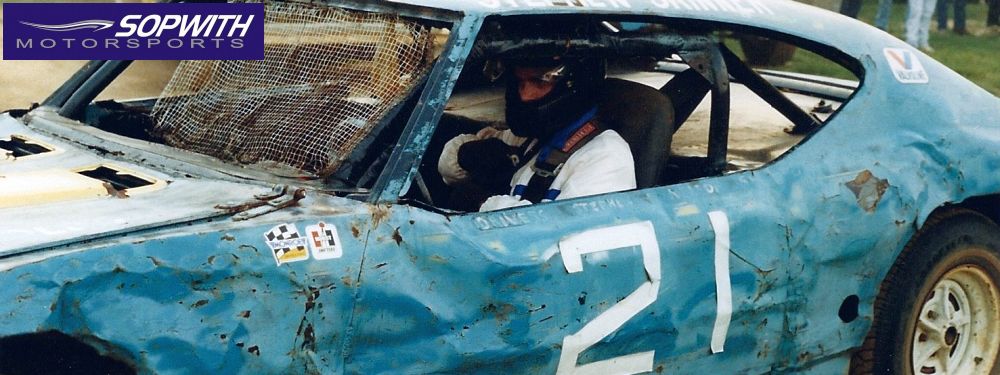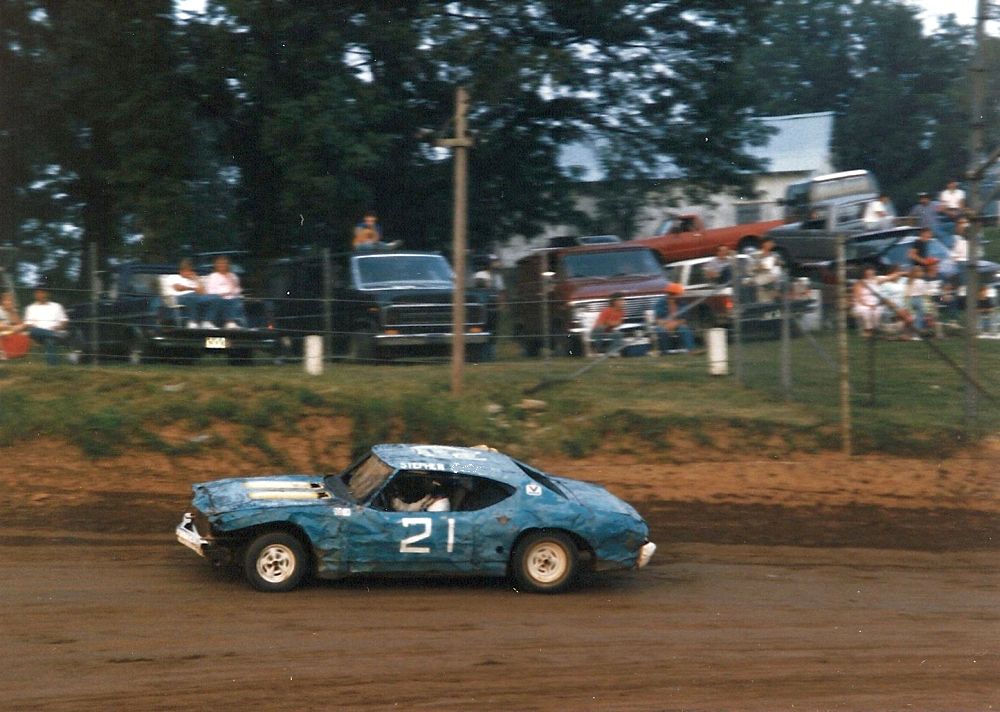
One Night at Paragon Speedway, 1989
(2/16/2014)

February 17, 2014, The Stephen Cox Blog is Presented by McGunegill Engine Performance, All photos courtesy SOPwithMotorsports
So I've been at my desk for half an hour now. I'm supposed to be writing this week's column on a new motorsports TV program. But I'm not. Instead, I'm poking around on the Mid-West Short Track Memories Facebook page and dreaming of a southern Indiana dirt track (Paragon Speedway) and a fun memory with my family.
It was Saturday afternoon, August 19, 1989. My helmet, a non-Snell approved motorcycle model from a nearby department store, was sitting on the roof of our 1968 Chevelle street stock while I used Scotch tape to affix two new tear-offs to the visor. Well, actually they weren't new. I couldn't afford new tear-offs. I found them on the floor of my car from the previous week's race, wiped them down and re-used them.

My sister, Dory, was checking the oil in our car's transplanted and perpetually overheating 455 Oldsmobile big block. Between the heat race and the feature, she would use a pressurized, hand-held garden sprayer to hose down the radiator with cool water.
My dad, Nelson, was busy setting the tire pressures. Not one of our tires matched in size, manufacturer or tread pattern. They all came from a used tire shop in Mooresville. We paid $7 for the best one, which we mounted on the right rear.
I had no fire suit. The rules didn't require them if you were wearing long sleeves. But I did have a really cool looking white vinyl jacket upon which my mother had skillfully sewn a Valvoline patch and the number of my car. A decade later would it occur to me that if my car had actually caught fire, that vinyl would have melted instantly and been worse than wearing no jacket at all. But ignorance is bliss.
Inside the car was a four-point racing harness with no anti-submarine belt. I sat in a bucket seat from an old Ford van that offered not the slightest lateral support. The outside of my right knee was bloody and bruised after every race, rubbed raw by the high-rise Hurst gear shifter that I leaned against. I eventually settled on an athletic knee pad, sliding the padding to the outside of my leg, to protect me. Occasionally it worked.

We were slow. I'd won one race in three years. Under the circumstances it was a miracle that we were on the track at all. We had no mechanical abilities, no previous racing knowledge or experience, nothing more than common hand tools, an ancient car and no budget. Today I would probably climb out of the car and declare it undrivable. But back then we were doing everything wrong and had no one to teach us any different. I had never driven another car and didn't know what a good car felt like. Worse yet, Paragon Speedway's street stock class was at the height of its glory, drawing 50-70 teams per night and sometimes holding a D Main event. The competition level was staggering.
For our little Garden Center Racing team (renamed “Sopwith Motorsports” in 1992), the barometer for success was low. Finishing anywhere but last was a small victory. Making the A Main and staying on the lead lap constituted a really outstanding night.
August 19, 1989 was no different. The pits were packed with scores of street stock machines. The Indiana air was heavy and humid from the previous week's rain. This article's main photo shows me entering Turn 1 in the final hot lap session of the night. Race tracks had no trouble filling grandstands back then, and those who could find no seats brought lawn chairs or sat atop their trucks and vans.
A close look at the number “21” on the side of my car shows that it was created from silver duct tape painted white with a spray can. When Dad drove the car (usually faster than me), we peeled the “1” off the car and placed it on the other side of the “2,” resulting in a number “12.” When I drove the car, we reversed the process to create a “21,” which was my high school basketball jersey number.
For Garden Center Racing, hot laps were not a search for speed. We just wanted to know if the car was going to run or not. That night, it did.

I started outside Row 2 in my oversized heat race, finishing somewhere in the back half of the field. We were assigned to the C Main, where I started at the back and drove to 7th place. My night was finished since only the top two transferred.
I made an early stop at the pay window while Dad and Dory loaded our car onto a flatbed trailer pulled by a red International pickup. The lady at the booth handed me an envelope containing a five dollar bill and three ones. Six dollars went toward gas money. The other two dollars were shoved back in the envelope and later placed carefully inside my scrapbook where they remain today.
We watched the rest of the night's racing from our perch on the pit grandstands, eating peanut butter crackers, Pringles and Pepsi. We couldn't afford concession stand food. And we never left early.
Somewhere around midnight we took State Road 67 north toward home. It was an unspectacular night by any measure, and I cannot explain why it stands out in my memory.
It was nights like August 19, 1989, along with a thousand others like it, that allowed me to claim my insignificant role in the history of American short track racing. With tracks closing left and right and fields diminishing annually, I don't take that for granted. Those were fun days and I'm grateful to have had a small glimpse of them.
I think I'll go back to the Mid-West Short Track Memories page now, and save the TV story for next week.
Maybe.
Stephen Cox
Sopwith Motorsports Television Productions
Co-host, Mecum Auto Auctions on NBCSN
#22 Boschett Timepieces/Acorn Cabinetry Racing Chevrolet
